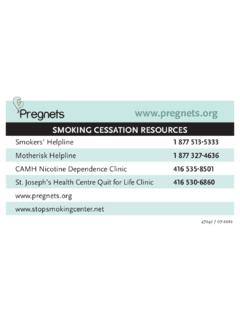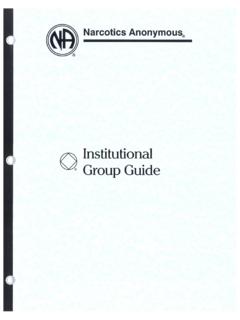Transcription of Specific Populations: Pregnant & Breastfeeding Women
1 Canadian Smoking Cessation Guideline Specific Populations: Pregnant & Breastfeeding Women CAN-ADAPTT's Clinical Practice Guideline Development Group;. Section Lead: Alice Ordean, MD, CCFP, MHSc Overview of Evidence CAN-ADAPTT Summary Statements Clinical Considerations Table 1. Negative Effects Associated with Cigarette Smoking during Pregnancy and Breastfeeding Tools/Resources Research Gaps Overview of Evidence The following recommendations, and supporting evidence, have been extracted from existing clinical practice guidelines to inform the development of the CAN-ADAPTT. Summary Statements. CAN-ADAPTT worked with the Guidelines Advisory Committee (GAC) to conduct a literature search (years: 2002-2009) to identify existing clinical practice guidelines (CPGs). Five existing clinical practice guidelines were identified as meeting the high quality criteria set out in the AGREE Instrument.
2 The recommendations contained in these high quality CPGs have been used as the evidence base for the CAN-ADAPTT. guideline development process. Visit to view CAN-ADAPTT's guideline development methodology. Version : Specific Populations: Pregnant and Breastfeeding Women March 31, 2011 1. Canadian Smoking Cessation Guideline Department of Health and Human Services Public Health Service (2008) 1. Because of the serious risks of smoking to the Pregnant smoker and the fetus, whenever possible Pregnant smokers should be offered person-to-person psychosocial interventions that exceed minimal advice to quit. (Strength of Evidence = A). Although abstinence early in pregnancy will produce the greatest benefits to the fetus and expectant mother, quitting at any point in pregnancy can yield benefits.
3 Therefore, clinicians should offer effective tobacco dependence interventions to Pregnant smokers at the first prenatal visit as well as throughout the course of pregnancy. (Strength of Evidence = B). New Zealand Ministry of Health (2007) 2. Offer all Pregnant and Breastfeeding Women who smoke multi-session behavioural smoking cessation interventions from a specialist/dedicated cessation service. (Grade=A). All health care workers should briefly advise Pregnant and Breastfeeding Women who smoke to stop smoking. (Grade = A). NRT can be used in pregnancy and during Breastfeeding following a risk-benefit assessment. If NRT is used, oral NRT products (for example, gum, inhalers, microtabs and lozenges) are preferable to nicotine patches. (Grade=C). Registered Nurses Association of Ontario (2007) 3.
4 Nurses implement, wherever possible, intensive intervention with Women who are Pregnant and postpartum. (Strength of Evidence = A). 1 Department of Health and Human Services Public Health Service. (2008, May). Clinical practice guideline: Treating tobacco use and dependence: 2008 update. 2 Ministry of Health. (2007, August). New Zealand smoking cessation guidelines. Wellington: Ministry of Health. 3 Registered Nurses Association of Ontario (RNAO). (2007, March). Integrating smoking cessation into daily nursing practice. Retrieved October 26, 2007 from: Version : Specific Populations: Pregnant and Breastfeeding Women March 31, 2011 2. Canadian Smoking Cessation Guideline CAN-ADAPTT Summary Statements Comment on the discussion board CAN-ADAPTT's development process reflects a dynamic opportunity to ensure that its guideline is practice informed and addresses issues of applicability in the Canadian context.
5 It has built from the evidence and recommendations contained in existing guidelines. It did not review the primary literature to inform the development of its Summary Statements unless emerging evidence was identified by the Guideline Development Group. The CAN-ADAPTT Guideline Development Group has provided the below Summary Statements for Pregnant and Breastfeeding Women . Version : Specific Populations: Pregnant and Breastfeeding Women March 31, 2011 3. Canadian Smoking Cessation Guideline Summary Statement #1 . Smoking cessation should be encouraged for all Pregnant , Breastfeeding and postpartum Women . GRADE*: 1A. Summary Statement #2 . During pregnancy and Breastfeeding , counselling is recommended as first line treatment for smoking cessation. GRADE*: 1A. Summary Statement #3.
6 If counselling is found ineffective, intermittent dosing nicotine replacement therapies (such as lozenges, gum) are preferred over continuous dosing of the patch after a risk-benefit analysis. GRADE*: 1C. Summary Statement #4 . Partners, friends and family members should also be offered smoking cessation interventions. GRADE*: 2B. Summary Statement #5 . A smoke-free home environment should be encouraged for Pregnant and Breastfeeding Women to avoid exposure to second-hand smoke. GRADE*: 1B. *GRADE: See below or click here for Grade of Recommendation and Level of Evidence Summary Table. Version : Specific Populations: Pregnant and Breastfeeding Women http://w March 31, 2011 4. Canadian Smoking Cessation Guideline Clinical Considerations Comment on the discussion board There is limited evidence on harms associated with the use of NRT during pregnancy.
7 Two prospective studies found no adverse maternal or fetal effects from the use of nicotine patch during pregnancy; however, one recent study demonstrated potential association between NRT and congenital defects. This data cannot support or exclude an association between first trimester NRT use and an increased risk of congenital defects due to several methodological issues. Therefore, until further information is available, the risks and benefits of smoking versus the use of NRT during pregnancy must be considered when counselling about smoking cessation options. There is some evidence from RCTs that NRT may be efficacious in pregnancy in terms of decreasing tobacco use and improving pregnancy outcomes. No safety concerns were identified in these trials. Therefore, benefits of NRT seem to outweigh potential risks; NRT should be considered when counselling has been ineffective.
8 Despite preliminary evidence that continued smoking and relapse are more likely among Pregnant Women who have a smoking partner, there is limited data regarding the benefits of partner involvement in smoking cessation interventions for Pregnant smokers. In non- Pregnant populations, interventions to increase support did not find increased quitting rates. Evidence from a recent systematic review and meta-analysis demonstrated negative perinatal outcomes ( trend towards lower birth weight, smaller head circumference and congenital anomalies) associated with second-hand smoke exposure. Therefore, Pregnant and Breastfeeding Women should avoid this environmental risk. Challenges in identification due to stigma associated with smoking during pregnancy. Smoking cessation interventions should be considered for the full spectrum of care from preconception visit to 1 year postpartum.
9 Smoking cessation counselling and care of Pregnant smokers may be conducted by physicians, allied healthcare professionals ( social worker, pharmacist, community health representatives), midwives, doulas, prenatal advisors, postpartum supports, family home visitors, and others. Version : Specific Populations: Pregnant and Breastfeeding Women March 31, 2011 5. Canadian Smoking Cessation Guideline Nicotine replacement therapy (NRT) can be considered as a second line option for individuals who cannot quit after counselling interventions. Depression during pregnancy is a common occurrence and the use of Zyban (bupropion) may be appropriate to treat both smoking and depression. There is limited evidence on the effectiveness of bupropion for smoking cessation during pregnancy. In addition, there is no evidence of harm related to the use of bupropion during pregnancy and therefore, it may be considered for use as an alternative to NRT for a subpopulation of Pregnant smokers (see Table 1 below).
10 Including partners, friends, and/or family in a Pregnant smoker's quit attempt is essential to increase the likelihood of successful smoking cessation interventions. A smoke-free home environment should be encouraged for partners, friends, family members of Pregnant and Breastfeeding Women to ensure safety from second-hand smoke/environmental tobacco smoke. Version : Specific Populations: Pregnant and Breastfeeding Women March 31, 2011 6. Canadian Smoking Cessation Guideline Table 1 Negative Effects Associated with Cigarette Smoking During Pregnancy and Breastfeeding Cigarette smoking during pregnancy and Breastfeeding is associated with numerous negative effects on mother, fetus, infant and adolescent. 4. Pregnancy Neonatal Long-Term Complications Effects Effects Subfertility (female and Low birth weight (on Childhood respiratory male) average ~200 grams smaller) illnesses (asthma, Ectopic pregnancy (outside Increased perinatal mortality pneumonia, bronchitis).)


